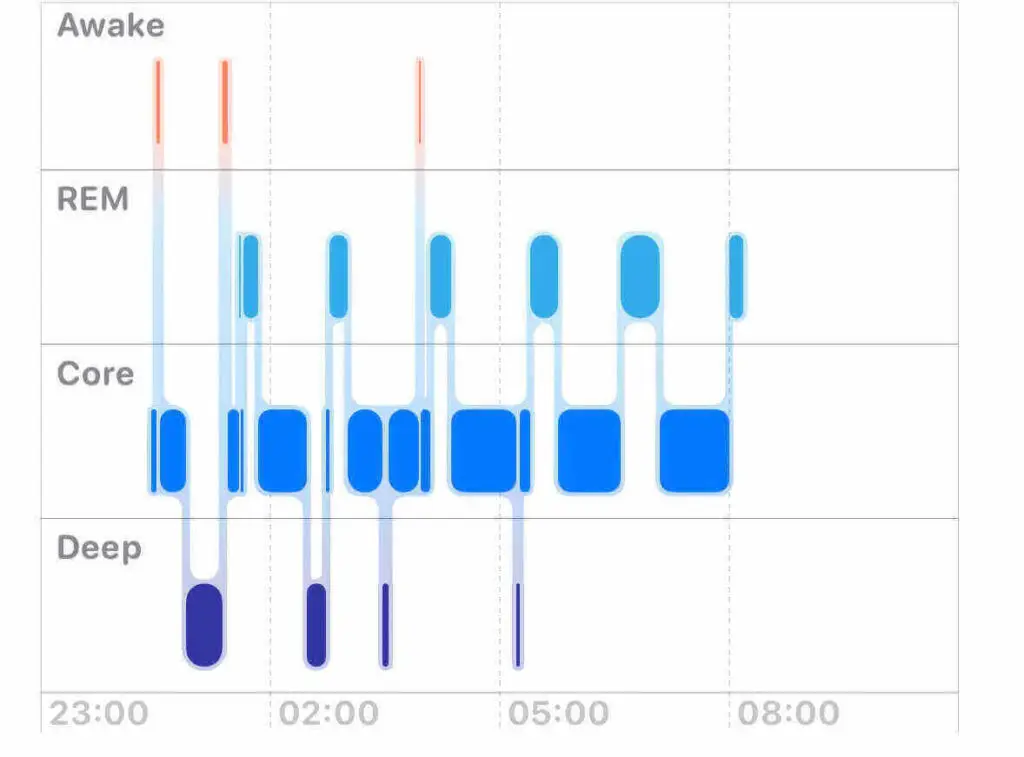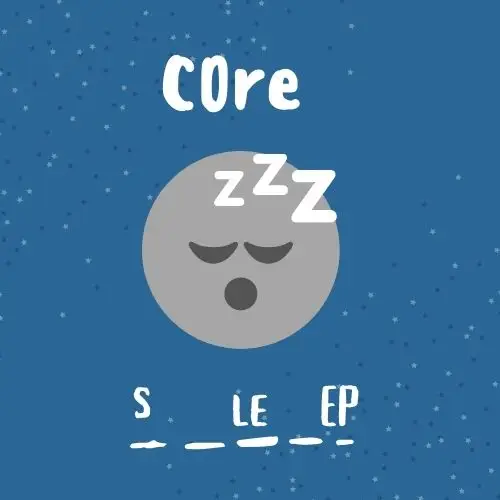I. Where Does “Core Sleep” Come From?
If you have used sleep tracker tools, you may have noticed the concept of “core sleep”. In fact, “core sleep” is not an officially recognized sleep stage, and there is no exact definition of “core sleep” in Wikipedia.
The term “core sleep” originally appeared in scientific literature to refer to the minimum amount of sleep needed to ensure normal functioning throughout the day.
Later, Apple reintroduced this term as a sleep stage monitored by their watch products, but this is entirely different from its original meaning in scientific literature.Apple Watch Sleep Record

II. What is Core Sleep, Light Sleep and Deep Sleep?
It’s common known that a night’s sleep consists of 4 to 6 sleep cycles, and each sleep cycle is made up of 4 sleep stages: non-rapid eye movement (NREM) stages (N1, N2, and N3) and a rapid eye movement (REM) stage.
Scientifically,N1 and N2 are considered as “light sleep”, while N3 is considered as “deep sleep”.
The “core sleep” in the Apple Watch actually corresponds to the scientifically defined “light sleep”, which includes the N1 and N2 stage.
Let’s take a closer look at how core sleep, light sleep, and deep sleep are nested within a sleep cycle:
NREM Stage 1 (N1): You’re just dozing off
Transitioning from being awake, we enter this stage where we’re half-asleep and half-awake. Both our brain activity and muscle power start to drop off. It’s pretty easy to wake us up at this point.
This stage only lasts a few minutes。
NREM Stage 2 (N2): Light sleep
This stage is commonly considered as “light sleep”, which is also the primary stage recorded as “core sleep” by the Apple Watch.
In this stage, our heart rate and body temperature begins to decrease. But if someone calls our name or a mom hears her baby crying, we can still snap back awake pretty quickly. We spend about half of our sleep time in this stage.
NREM Stage 3 (N3): Deep sleep
Deep sleep is also known as slow-wave sleep. This is because our brains are generating the slowest type of brainwaves – Delta waves (as opposed to the high-speed Beta waves when we’re awake).
It’s tough to wake someone up from this stage. And if you do get woken up, you’ll find yourself all groggy and confused.
REM Stage: Dreaming stage
In REM stage, our muscle tension is almost zero, and we dream. Most of our dreaming happens here.
This stage is thought to be good for reorganizing and linking information, and unleashing creativity. Again, we expect this stage to account for about 20% of sleep time.

III. Is Core Sleep Better Than Deep Sleep?
Core sleep (light sleep) and deep sleep are two important stages of the sleep cycle, each serving distinct functions.
Core Sleep vs Deep Sleep
| Core Sleep | Deep Sleep | |
| Sleep Stage: | N1 and N2 stage | N3 stage |
| Characteristics: | -Heart rate and breathing become more regular.- Body temperature drops.- Brain waves slow down, with sleep spindles and K-complexes appearing. | -The body is in its most restful state.-Brain waves are slow (delta waves).-It is harder to wake someone from deep sleep. |
| Function: | -Memory consolidation;-Information processing;-Emotional regulation. | – physical recovery and growth;-Supports immune function and energy restoration;-Plays a key role in the release of growth hormones. |
| Duration: | Typically comprises a significant portion of the total sleep time | Usually occurs in longer periods during the first half of the night. |
Core Sleep is essential for cognitive functions and emotional health, while Deep Sleep is vital for physical restoration and recovery.
Both stages are crucial for overall health, and a balanced sleep cycle should include adequate time spent in both core and deep sleep.
IV. How Much Core, Deep, and REM Sleep Do You Need?
The amount of core, deep, and REM sleep needed varies depending on individual factors such as age, lifestyle, and overall health. Here are general guidelines for each stage of sleep:
Core Sleep (Light Sleep):
Adults typically need about 7-9 hours of total sleep per night, Core sleep can constitute around 50-60% of total sleep time, so ideally, adults should aim for 3.5-5 hours of core sleep per night.
Deep Sleep:
Deep sleep is most prominent during the first half of the night. Adults generally require 1-2 hours of deep sleep per night, but this can vary.
REM Sleep:
REM sleep occurs in shorter intervals throughout the night, with each REM cycle lengthening as the night progresses. Adults typically spend about 20-25% of total sleep time in REM sleep, which equates to approximately 1.5-2 hours for a full night’s sleep.
V. What to Do if You are Stuck in Core Sleep
If deep sleep is very minimal, being stuck in light sleep (core sleep) can cause significant harm to your health.
Some sleep tips you can take to enhance your sleep:
- Go to bed only when sleepy and avoid napping on the couch early in the evening.
- If unable to sleep, get up and engage in quiet activities until sleepiness returns.
- Avoid napping during the day if nighttime sleep is difficult.
- Learn to relax before going to bed to reduce anxiety-inducing thoughts and worries.
- Keep visible clocks out of the bedroom to avoid anxiety from clock-watching.
VI. Conclusion
Fully understanding the importance of core sleep and deep sleep in health and maintaining a balanced sleep cycle is crucial.
